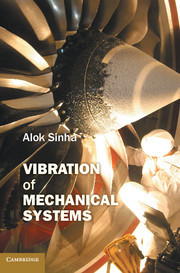Description
Vibration of Mechanical Systems
Author: Sinha Alok
A brief yet complete textbook for a first course in mechanical vibrations with more than sixty exercise problems where using MATLAB® is emphasized.
Language: English
Subjects for Vibration of Mechanical Systems:
Vibration of Mechanical Systems
Publication date: 05-2014
326 p. · 15.1x22.8 cm · Paperback
Publication date: 05-2014
326 p. · 15.1x22.8 cm · Paperback
Vibration of mechanical systems
Publication date: 10-2010
328 p. · 15.8x23.5 cm · Hardback
Publication date: 10-2010
328 p. · 15.8x23.5 cm · Hardback
Description
/li>Contents
/li>Biography
/li>
This is a textbook for a first course in mechanical vibrations. There are many books in this area that try to include everything, thus they have become exhaustive compendiums, overwhelming for the undergraduate. In this book, all the basic concepts in mechanical vibrations are clearly identified and presented in a concise and simple manner with illustrative and practical examples. Vibration concepts include a review of selected topics in mechanics; a description of single-degree-of-freedom (SDOF) systems in terms of equivalent mass, equivalent stiffness, and equivalent damping; a unified treatment of various forced response problems (base excitation and rotating balance); an introduction to systems thinking, highlighting the fact that SDOF analysis is a building block for multi-degree-of-freedom (MDOF) and continuous system analyses via modal analysis; and a simple introduction to finite element analysis to connect continuous system and MDOF analyses. There are more than sixty exercise problems, and a complete solutions manual. The use of MATLAB® software is emphasized.
1. Equivalent single degree of freedom system and free vibration; 2. Vibration of a single degree of freedom system under constant and purely harmonic excitation; 3. Responses of a SDOF spring-mass-damper system to periodic and arbitrary forces; 4. Vibration of two degrees of freedom systems; 5. Finite and infinite (continuous) dimensional systems; References; Appendix A; Appendix B; Appendix C.
Alok Sinha is a Professor of Mechanical Engineering at Pennsylvania State University (PSU), University Park. He received his PhD degree in Mechanical Engineering from Carnegie Mellon University, Pittsburgh, PA. He has been a PSU faculty member since August 1983. His areas of teaching and research are vibration, control systems, jet engines, robotics, neural networks and nanotechnology. He is the author of Linear Systems: Optimal and Robust Control. He has served as a Visiting Associate Professor of Aeronautics and Astronautics at Massachusetts Institute of Technology, Cambridge, MA, and as a researcher at Pratt and Whitney, E. Hartford, CT. He has also been an associate editor of the ASME Journal of Dynamic Systems, Measurement and Control. At present, he serves as Associate Editor of the ASME Journal of Turbomachinery and the AIAA Journal. Alok Sinha is also a Fellow of ASME, and has received a NASA Certificate of Recognition for Significant Contribution to the Space Shuttle Microgravity Mission.
© 2024 LAVOISIER S.A.S.
These books may interest you

Isospectral Vibrating Systems 184.47 €



